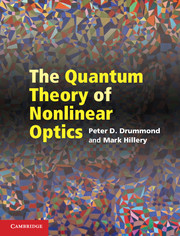Book contents
- Frontmatter
- Contents
- Preface
- Introduction
- 1 Classical nonlinear optics
- 2 Field quantization
- 3 Quantized fields in dielectric media
- 4 Microscopic description of media
- 5 Coherence and quantum dynamics in simple systems
- 6 Decoherence and reservoirs
- 7 Phase-space distributions
- 8 Single-mode devices
- 9 Degenerate parametric oscillator
- 10 Quantum field dynamics
- 11 Quantum propagation in fibers and waveguides
- 12 Quantum information
- List of symbols
- Index
- References
7 - Phase-space distributions
Published online by Cambridge University Press: 05 May 2014
- Frontmatter
- Contents
- Preface
- Introduction
- 1 Classical nonlinear optics
- 2 Field quantization
- 3 Quantized fields in dielectric media
- 4 Microscopic description of media
- 5 Coherence and quantum dynamics in simple systems
- 6 Decoherence and reservoirs
- 7 Phase-space distributions
- 8 Single-mode devices
- 9 Degenerate parametric oscillator
- 10 Quantum field dynamics
- 11 Quantum propagation in fibers and waveguides
- 12 Quantum information
- List of symbols
- Index
- References
Summary
In this chapter, we will develop methods for mapping operator equations to equivalent c-number equations. This results in a continuous phase-space representation of a many-body quantum system, using phase-space distributions instead of density matrices. In order to do this, we will first find c-number representations of operators. We have already seen one such representation, the Glauber–Sudarshan P-representation for the density matrix. We now introduce several more such representations. The main focus will be on the truncated Wigner representation, valid at large photon number, and the positive P-representation, which uses a double-dimensional phase space and exists as a positive probability for all quantum density matrices.
Phase-space techniques have a great advantage over conventional matrix-type solutions to the Schrödinger equation, in that they do not have an exponential growth in complexity with mode and particle number. Instead, the equations that describe the dynamics of these c-number representations of the density matrix are Fokker–Planck equations. These have equivalent stochastic differential equations, which behave as c-number analogs of Heisenberg-picture equations of motion.
This means that problems that would be essentially impossible to solve using conventional number-state representations can be transformed into readily soluble differential equations. In many cases, no additional approximations, such as perturbation theory or factorization assumptions, are needed.
- Type
- Chapter
- Information
- The Quantum Theory of Nonlinear Optics , pp. 217 - 255Publisher: Cambridge University PressPrint publication year: 2014

